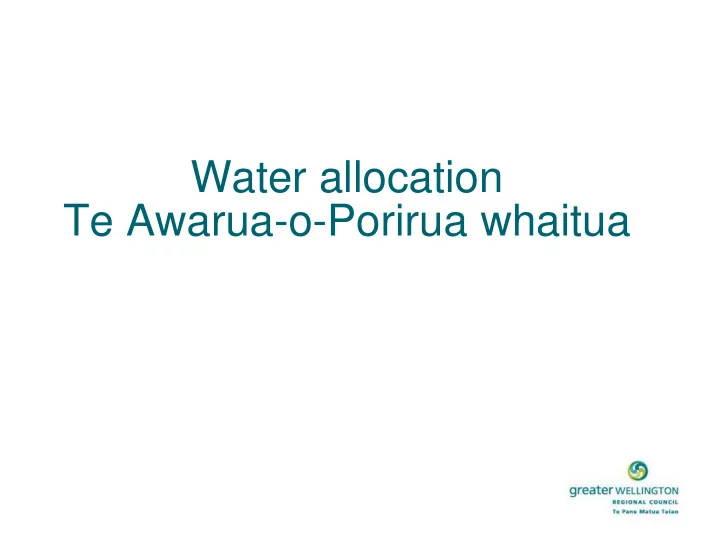

Water allocation Te Awarua-o-Porirua whaitua
Water allocation topics • Connection with values and objectives • Setting limits Decisions needed • Permitted activities • Managing within limits
High level objectives and values Eg. • Mahinga kai • Diverse and healthy ecosystems • Sustainable land management
Setting limits We set at least 2 types of limits: • Minimum flow limits • Allocation limits …in order to provide • Habitat protection; and… • Reliable water supply …that contribute to achieving your objectives
The “default” limits are… • Minimum flow limits = 90% MALF • Allocation limits = 30% MALF These came from national defaults (“ Proposed NES”) put into the existing proposed GW plan. But we’ve now modelled their effect for Porirua streams – for both habitat & supply reliability [MALF = mean annual low flow = common “low” flow statistic]
What do default limits achieve? –for habitat protection ? • 14 native freshwater fish species present in the Whaitua • Analysed 8 species broadly & 2 indicator species in detail • 98% of low flow habitat for tuna ( long-fin eels ) • 89% of low flow habitat for trout • Other native fish between these ( >90%)
What do default limits achieve? –for reliability of supply ? • 10-14% of the time consented water takes must reduce to take less than full amount (i.e. “partial restrictions) • 6-9% of time water takes must cease • This reliability of supply is comparable or better than elsewhere in region
Habitat prot. Vs Supply for use • Recognise there is a trade-off between these. • Need value judgement decision on the balance. • Higher minimum flows & smaller allocation limits give more habitat, but less use. • Do the default limits (90/30) strike a fairly protective balance?
How do the limits work? … lets work through an example… Ask Questions!!!
e.g., Pauatahunui Stream
Managing within limits • Establish numerical limits in all catchments • Establish how much water is taken (consents and permitted) • Ensure water takes cease at minimum flows
Recap • Default minimum flows (90% MALF) • Default allocation limits (30% MALF) • Good habitat prot. (98% tuna; 89% trout; other >90%) • Modest reliability of supply for use • Decision on 90/30 balance OK, or other?
THE WATER ALLOCATION BUCKET ALLOCATION LIMIT CONSENTED WATER TAKES OTHER PERMITTED ACTIVITY WATER USE STOCK DRINKING WATER & DOMESTIC USE
Pautahanui Stream water allocation bucket PERMITTED ACTIVITY WATER USE 47.5 l/s CONSENTED CONSENTED WATER TAKES WATER TAKES 29 litres per 27.5 l/s second STOCK DRINKING WATER & DOMESTIC USE 3.5 l/s
Permitted activity options • Simple • Comparable to other councils and elsewhere in region • Reduce the permitted activity block to 5 m 3 per day • Cutoff at minimum flow
Recommend
More recommend